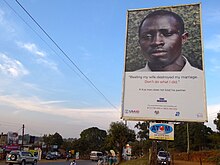Domestic violence
Domestic violence is a form of violence or abuse that happens among people living together in a common household. Very often, such people are married, or they live in a relationship.


The relationship or marriage may be between people of opposite sex (a man and a woman), but it can also be among people of the same sex. There can also be children in the household.
Violence between adult partners of a relationship is the most common type of domestic violence. There are also violent acts of adults against children, of children against adults, and violence against elderly people.
The exact definitions of what is domestic violence vary by country. In general though, the legal definitions only include the acts, and their punishment. People from sociology and psychology also look at the motivations (why the person became violent).
Like other forms of violence, domestic violence often has a repeating pattern, known as cycle of violence, or cycle of abuse.[1] If violence is unreported, it may get worse over time.
The person becoming violent often wants to get more power and more control over another person. When the cycle of violence starts people are said to be losing their temper.
Domestic violence can be a cause for becoming homeless.[2][3]
Most of the time, the victims of domestic violence are women. They may experience more severe forms of violence.[4][5] The World Health Organization (WHO) estimates 1 in 3 of all women are subject to domestic violence at some point in their life.[6] Women are also more likely than men to use intimate partner violence in self-defense.[7]
Some countries do not have good laws covering domestic violence. In these countries domestic violence may be permitted, especially in the case where the woman is suspected of infidelity. There seems to be a correlation between the level of gender equality, and the level of domestic violence. Countries with less gender equality have higher rates of domestic violence.[8]
Very often, incidents of domestic violence are not reported; this is true for both men and women.[9][10] There is a social stigma: Most people believe that women are victims of domestic violence, most of the time. That way, healthcare providers often overlook men who are victims of domestic violence.[11][12][13][14]
Children
changeIf we go back a century or two, we find that in some countries, children were often beaten, both at home and at school. Now that is much rarer, and may be forbidden in law. The key term to search for this topic is "corporal punishment".
Forms
changeThere are different forms of domestic abuse, not all of which are violent:
- Physical abuse: this usually means physical beating, but sometimes involves other serious actions, such as acid throwing
- Sexual abuse, many forms of rape
- Psychological abuse
References
change- ↑ "What is the cycle of violence?". Verywell Mind. Retrieved 2022-11-12.
- ↑ "Domestic violence and homelessness". www.acf.hhs.gov. Archived from the original on 2022-05-10. Retrieved 2022-11-12.
- ↑ "Domestic Violence and Homelessness: Statistics (2016)". www.acf.hhs.gov. Retrieved 2022-11-12.
- ↑ McQuigg, Ronagh J.A. (2011), "Potential problems for the effectiveness of international human rights law as regards domestic violence", in McQuigg, Ronagh J.A. (ed.), International human rights law and domestic violence: the effectiveness of international human rights law, Oxford New York: Taylor & Francis, p. 13, ISBN 9781136742088,
This is an issue that affects vast numbers of women throughout all nations of the world. ... Although there are cases in which men are the victims of domestic violence, nevertheless 'the available research suggests that domestic violence is overwhelmingly directed by men against women ... In addition, violence used by men against female partners tends to be much more severe than that used by women against men. Mullender and Morley state that 'Domestic violence against women is the most common form of family violence worldwide.'
- ↑ García-Moreno, Claudia; Stöckl, Heidi (2013), "Protection of sexual and reproductive health rights: addressing violence against women", in Grodin, Michael A.; Tarantola, Daniel; Annas, George J.; et al. (eds.), Health and human rights in a changing world, Routledge, pp. 780–781, ISBN 9781136688638,
Intimate male partners are most often the main perpetrators of violence against women, a form of violence known as intimate partner violence, 'domestic' violence or 'spousal (or wife) abuse.' Intimate partner violence and sexual violence, whether by partners, acquaintances or strangers, are common worldwide and disproportionately affect women, although are not exclusive to them.
- ↑ "Violence against women". www.who.int. Retrieved 2022-07-25.
- ↑ Swan, Suzanne C.; Gambone, Laura J.; Caldwell, Jennifer E.; Sullivan, Tami P.; Snow, David L. (2008). "A Review of Research on Women's Use of Violence With Male Intimate Partners". Violence and Victims. 23 (3): 301–314. doi:10.1891/0886-6708.23.3.301. PMC 2968709. PMID 18624096.
- ↑ Esquivel-Santoveña, Esteban Eugenio; Lambert, Teri L.; Hamel, John (January 2013). "Partner abuse worldwide" (PDF). Partner Abuse. 4 (1): 6–75. doi:10.1891/1946-6560.4.1.6. S2CID 143682579. Archived (PDF) from the original on 2016-02-05.
- ↑ Strong, Bryan; DeVault, Christine; Cohen, Theodore (February 16, 2010). The Marriage and Family Experience: intimate relationships in a changing society. Cengage Learning. p. 447. ISBN 978-1133597469.
- ↑ Concannon, Diana (July 11, 2013). Kidnapping: An Investigator's Guide. Newnes. p. 30. ISBN 978-0123740311.
- ↑ Riviello, Ralph (July 1, 2009). Manual of Forensic Emergency Medicine. Jones & Bartlett Learning. p. 129. ISBN 978-0763744625.
- ↑ Finley, Laura (July 16, 2013). Encyclopedia of Domestic Violence and Abuse. ABC-CLIO. p. 163. ISBN 978-1610690010.
- ↑ Hess, Kären; Orthmann, Christine; Cho, Henry (January 1, 2016). Criminal Investigation. Cengage Learning. p. 323. ISBN 978-1435469938.
- ↑ Lupri, Eugene; Grandin, Elaine (2004), "Consequences of male abuse – direct and indirect", in Lupri, Eugene; Grandin, Elaine (eds.), Intimate partner abuse against men (PDF), Ottawa: National Clearinghouse on Family Violence, p. 6, ISBN 9780662379751, archived from the original (PDF) on January 4, 2009, retrieved June 21, 2014
Related pages
change- Domestic Abuse Advice
- Cycle of abuse (patterns in relationships where there is domestic violence)
- Istanbul Convention
- Violence against women